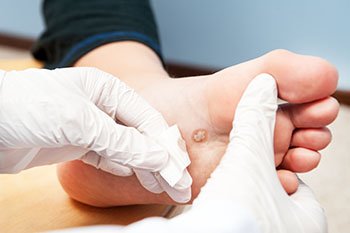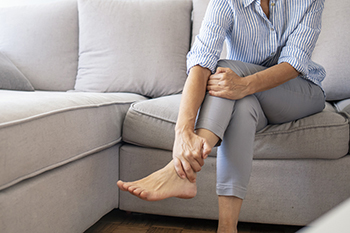

There are several areas of the foot that can become painful. Some people experience toe pain, heel pain, or even toenail pain when specific shoes are worn, or activities are pursued. Plantar fasciitis is a common foot condition that can cause severe pain and discomfort, and treatment is suggested to begin at the first signs of pain. Heel pain is often associated with this condition, and may radiate to the Achilles tendon. Toe pain may be the result of the ailment known as gout, or it may develop from having a bunion. Additionally, corns can cause extreme pain, especially when one forms on the outside of the pinky toe. Pain in the toenails may be what is referred to as a subungual hematoma, and can happen from excessive rubbing of the toes against the shoe. Extensor tendonitis may be the cause for pain on top of the foot, which can be accompanied by swelling and difficulty in running. If you have pain in any area of your foot, it is strongly suggested that you seek the expert advice from a podiatrist who can determine why it is occurring, and treat it accordingly.
Foot Pain
Foot pain can be extremely painful and debilitating. If you have a foot pain, consult with one of our podiatrists from Grand Blanc Family Footcare. Our doctors will assess your condition and provide you with quality foot and ankle treatment.
Causes
Foot pain is a very broad condition that could be caused by one or more ailments. The most common include:
Diagnosis
To figure out the cause of foot pain, podiatrists utilize several different methods. This can range from simple visual inspections and sensation tests to X-rays and MRI scans. Prior medical history, family medical history, and any recent physical traumatic events will all be taken into consideration for a proper diagnosis.
Treatment
Treatment depends upon the cause of the foot pain. Whether it is resting, staying off the foot, or having surgery; podiatrists have a number of treatment options available for foot pain.
If you have any questions, please feel free to contact our office located in Grand Blanc, MI . We offer the newest diagnostic and treatment technologies for all your foot care needs.

Plantar warts are essentially growths on the feet and they can develop when an individual contracts the human papillomavirus, also known as HPV. These warts can feel hard on the feet and in some cases, they might cause pain. Plantar warts can develop when an individual has skin contact with HPV. Importantly, HPV may be transmitted to someone when they fail to wear shoes in a public area, such as locker rooms and public pool areas. It is also common for someone to contract HPV from infected household members. If you have plantar warts, it might be advisable to take precautions to limit the extent to which you are spreading the human papillomavirus to others. This might include wearing shoes around the house if you live with others. Contact a podiatrist today if you think that you have plantar warts and want to treat this condition.
Plantar warts can be very uncomfortable. If you need your feet checked, contact one of our podiatrists from Grand Blanc Family Footcare. Our doctors will assist you with all of your foot and ankle needs.
About Plantar Warts
Plantar warts are the result of HPV, or human papillomavirus, getting into open wounds on the feet. They are mostly found on the heels or balls of the feet.
While plantar warts are generally harmless, those experiencing excessive pain or those suffering from diabetes or a compromised immune system require immediate medical care. Plantar warts are easily diagnosed, usually through scraping off a bit of rough skin or by getting a biopsy.
Symptoms
Treatment
To help prevent developing plantar warts, avoid walking barefoot over abrasive surfaces that can cause cuts or wounds for HPV to get into. Avoiding direct contact with other warts, as well as not picking or rubbing existing warts, can help prevent the further spread of plantar warts. However, if you think you have developed plantar warts, speak to your podiatrist. He or she can diagnose the warts on your feet and recommend the appropriate treatment options.
If you have any questions please feel free to contact our office located in Grand Blanc, MI . We offer the newest diagnostic and treatment technologies for all your foot and ankle needs.

Individuals living with rheumatoid arthritis (RA) may experience swelling in certain smaller joints in the body, including those in the toes of the feet. RA can cause a number of different toe conditions to be aware of. Notably, it can cause claw toe, which is a condition where the toes essentially twist or bend into a position that resembles a claw. People with rheumatoid arthritis may also have bursitis, which is when the fluid sacs in the joints become aggravated and inflamed. Another common toe condition for those with RA is corns of the feet, thick areas of skin that develop in response to friction. These are just some of the different relevant toe conditions for those with RA. It is important to note that people with this kind of arthritis can experience a combination of different toe conditions at the same time, which can make wearing shoes especially uncomfortable. Contact a podiatrist today if you are living with rheumatoid arthritis and want to protect your toes.
Because RA affects more than just your joints, including the joints in your feet and ankles, it is important to seek early diagnosis from your podiatrist if you feel like the pain in your feet might be caused by RA. For more information, contact one of our podiatrists of Grand Blanc Family Footcare. Our doctors will assist you with all of your podiatric concerns.
What Is Rheumatoid Arthritis?
Rheumatoid Arthritis (RA) is an autoimmune disorder in which the body’s own immune system attacks the membranes surrounding the joints. Inflammation of the lining and eventually the destruction of the joint’s cartilage and bone occur, causing severe pain and immobility.
Rheumatoid Arthritis of the Feet
Although RA usually attacks multiple bones and joints throughout the entire body, almost 90 percent of cases result in pain in the foot or ankle area.
Symptoms
Diagnosis
Quick diagnosis of RA in the feet is important so that the podiatrist can treat the area effectively. Your doctor will ask you about your medical history, occupation, and lifestyle to determine the origin of the condition. Rheumatoid Factor tests help to determine if someone is affected by the disease.
If you have any questions please feel free to contact our office located in Grand Blanc, MI . We offer the newest diagnostic and treatment technologies for all your foot and ankle needs.

A heel spur is a bony protrusion on the underside of the calcaneus or heel bone. A heel spur can extend as much as half an inch from the bone. Some heel spurs are painless, but others can induce chronic pain that is sometimes associated with plantar fasciitis. These spurs are more common among athletes who do a lot of jumping and running. Risks for the development of heel spurs include running or jogging on hard surfaces, gait abnormalities that place excessive stress on the calcaneus, and being overweight. In addition, poorly fitted shoes that lack sufficient arch support can increase the risk of heel spurs. Just the process of aging can be a risk factor as the result of thinning fat pads in the heels. Other risks are engaging in short bursts of activity, spending an excessive amount of time on your feet, and having flat feet or high arches. Prevention tips include wearing well-fitting shoes with ample heel support and shock-absorbing soles. In some cases, custom orthotics may be the answer. For details on dealing with heel spurs and information on orthotics, please consult a podiatrist.
Heel spurs can be incredibly painful and sometimes may make you unable to participate in physical activities. To get medical care for your heel spurs, contact one of our podiatrists from Grand Blanc Family Footcare. Our doctors will do everything possible to treat your condition.
Heels Spurs
Heel spurs are formed by calcium deposits on the back of the foot where the heel is. This can also be caused by small fragments of bone breaking off one section of the foot, attaching onto the back of the foot. Heel spurs can also be bone growth on the back of the foot and may grow in the direction of the arch of the foot.
Older individuals usually suffer from heel spurs and pain sometimes intensifies with age. One of the main condition's spurs are related to is plantar fasciitis.
Pain
The pain associated with spurs is often because of weight placed on the feet. When someone is walking, their entire weight is concentrated on the feet. Bone spurs then have the tendency to affect other bones and tissues around the foot. As the pain continues, the feet will become tender and sensitive over time.
Treatments
There are many ways to treat heel spurs. If one is suffering from heel spurs in conjunction with pain, there are several methods for healing. Medication, surgery, and herbal care are some options.
If you have any questions feel free to contact our office located in Grand Blanc, MI . We offer the latest in diagnostic and treatment technology to meet your needs.